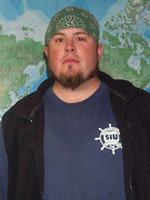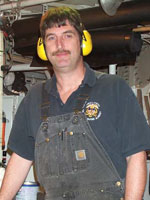Daily Journal
September 17, 2004:
Aboard the R/V Wecoma: The Crew (Part 2)
 Gary Stevenson, Second Mate Gary Stevenson, Second Mate
Gary has had a lifelong relationship with the sea since the age of
sixteen. His land home is in Depoe Bay, Oregon. He has been in the coast
guard, worked on commercial fishing boats in both Alaska and Oregon
waters. He has worked on off-shore tugboats and other ships. He's been
part of the Wecoma crew for eight years. His duties as second mate include
navigation, loading and securing food and equipment, and covering work
shifts for others. The thing he likes best about his work is the travel to
foreign ports.
He uses lots of math everyday and says he learns a lot on the job.There
are many forms and documents that are used in navigation that require
math. He said he would like to tell our students to "study your math."
 Kyle Bailey, Able Bodied Seaman Kyle Bailey, Able Bodied Seaman
Kyle's land home is on the Klamath River in Northern California. He has
also worked in the timber industry, construction, Department of Fish and
Game, private industry sailing, and for the U.S. Navy. He has attended a
Maritime Academy, earned a Merchant Marine License, and multiple other
endorsements including Fire Fighting. He has been a Merchant Marine for 8
years, and has worked aboard the Wecoma since July 2004. He received his
training from Paul Hall Maritime Institute in Piney Point, Maryland. This is
a union school for SeaFarers
International.
His favorite duty while on board ship is the 8:00-12:00 noon watch for the
Captain on the Bridge (Pilot Room). He also likes to deploy the CTD meter
(Rosette) using the crane. He absolutely must use math every day to plot
the course, deploy scientific equipment by regulating the tension and
speed of the cable of the equipment.
Kyle also enjoys meeting the scientists who are doing research. He would
like our students to know, "Hope is out there, and education is the key."
He said there are jobs available in the Merchant Marines and there is a
Mercant Marine School in Oregon through the Job Corps.
 Hank Hazen, Engineer Hank Hazen, Engineer
Hank, like his fellow crewmates, has been working at sea for many years.
He has been in the Merchant Marines for the past four years. His home is
in Portland, Oregon. He worked in construction for the Navy in Okinawa,
Guam, and Italy. He has also been a carpenter and was a commercial
fisherman in the Bering Sea.
He has been with the Wecoma for the past two years. His duties include
maintenance of propulsion, power machinery, and he especially enjoys
working with refrigeration units. He uses math daily to calculate gallons
per hour, and percentages for mixing chemicals. He said knowledge of
decimals is critical. For example, the difference between 0.1 and 0.01
would have a serious impact upon chemical mixtures or the water supply.
He would like students to be really sure you like the sea before you
commit to this occupation. Hank has always lived close to the sea and said
he feels best when near the ocean.
Here are some math problems:
In order to purify water, you need to add 0.3 ppm (parts per million) of
chlorine. This means that for every 1,000,000 liters of water you would
need to add 0.3 liters of chlorine. If you had 1,000 liters of water, how
much chlorine would you need to add to purify it?
Here's another problem. When a ship is at sea for a length of time, you
must be able to convert salt water to fresh water. This is done with a
water maker. The water maker boils salt water into steam, the steam is
then condensed into a container as fresh water. In order for the water
maker to operate efficiently, a descaler must be added. This holds the
salt in solution and prevents it from crystalizing and clogging the outlet
of the water maker. The ratio of descaler added is 2 cups to 28 gallons of
water. If our water maker holds 100 gallons of water, how much descaler
should we add?


Top: A sea of undulating glass
Above: Sunrise at sea
Back to Daily Journals

|







